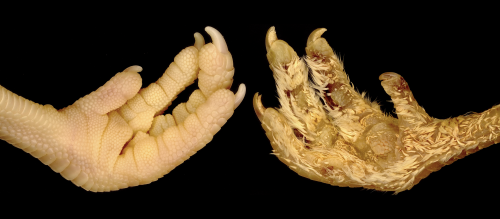Behind the paper: how to turn scales into feathers
Posted by rorylcooper, on 16 June 2023
A recent paper in Science Advances entitled ‘Transient agonism of the sonic hedgehog pathway triggers a permanent transition of skin appendage fate in the chicken embryo’ reports an experimental method for transforming chicken scales into true feathers (1). We caught up with Dr. Rory Cooper, the first author of the article, to find out more about the story behind the paper.

How did you get started on this project?
I became interested in the evolution and development of skin appendages (such as scales, spines and feathers) during my PhD with Dr. Gareth Fraser, when I was studying the patterning of scales and teeth in the shark. I wanted to continue working in this field, and luckily the LANE (Milinkovitch-Tzika lab) advertised a postdoc position at just the right time. This lab is renowned for studying skin appendage development in really diverse non-classical models such as snakes, lizards and exotic mammals, so it was the perfect destination for me. One key finding by Michel Milinkovitch & his then post-doc Nicolas Di-Poï, was that not only hair and feathers, but also reptilian scales, develop from placodes – localised thickenings of the skin that constitute the foundations of most skin appendages (2). When I arrived in the LANE in 2020, there was already an ongoing project investigating chicken scale development, so it was easy for me to get started straight away.
What was already known about ectopic feather induction in chicken embryos?
There have been a few published articles reporting a scale-to-feather conversion in the chicken embryo (3-5). However, the results of these studies are variable. First, not all of these scale-to-feather conversions result in true, regenerative feathers, second, the coverage of these ectopic feathers was not ubiquitous, and third, the post-embryonic development of these feathers had not been examined. Also, our lab had recently developed a really nice protocol for injecting precise quantities of drugs directly into the veins of developing chicken embryos (as well as other hard-shelled eggs) (6). You can check this out in the video below. This project provided a great opportunity to try out this method.
Can you summarise your key findings?
We investigated the role of the sonic hedgehog (Shh) pathway in mediating skin appendage fate in the chicken. This pathway is essential for loads of developmental events, and is really important in controlling the early development of placodes. We injected a precise dose of a Shh pathway activator directly into the blood stream of developing embryos (6), at the exact time that scales begin to appear on their footpads. We then collected the embryos at various stages after injection, and even allowed some to hatch so that we could examine the effect in adult chickens. Incredibly, every single chickens injected with the Shh activator had abundant ectopic feathers covering their feet. We tracked the development of these ectopic feathers in hatched chickens, and saw that they transitioned from juvenile down-type feathers into true contour feathers observed in adult birds. This confirmed that our experimentally-induced feathers are true, regenerative feathers.
Movie showing a 3D reconstruction of light-sheet fluorescence microscopy imaging showing experimentally induced ectopic feather buds in the embryonic chicken © UNIGE / Cooper, Megahed & Milinkovitch
When doing the research, did you have any particular result or eureka moment that has stuck with you?
I distinctly remember looking at the first treated sample under the microscope – it was collected after 4 days, meaning that the ectopic feather buds were still relatively undeveloped. At first glance it looked like an incredibly hairy chicken foot. I showed the sample to my boss, and he suggested that we should see what happened if we allowed the embryos to develop until hatching. A few weeks later we had our first feather-footed hatchling chickens!
And what about the flipside: any moments of frustration or despair?
Whilst attempting to harvest samples for RNAseq, the treatment suddenly began to kill all of the embryos. As there was a short power outage in our lab during the incubation of the eggs, I initially assumed that the embryos were slightly less developed than before. I then repeated the experiment with fresh eggs, and exactly the same thing happened. Finally, I contacted the farmer who provides the eggs, and he told us that they had just replaced their laying hens, meaning that the eggs were now coming from much younger chickens, which lay much smaller eggs. After adjusting the treatment to account for this change, the experiment worked perfectly.
What is next for you after this paper?
I’m working on some more really exciting skin appendage-related projects in the Milinkovitch-Tzika lab. We have an additional manuscript on chicken scale development in the pipeline, and Michel has had me heavily involved me in another project on crocodile scale patterning – they’re both really cool stories, and hopefully we will be able to share them with you soon!
References
1. R. L. Cooper, M. C. Milinkovitch, Transient agonism of the sonic hedgehog pathway triggers a permanent transition of skin appendage fate in the chicken embryo. Science Advances 9, eadg9619 (2023).
2. N. Di-Poï, M. C. Milinkovitch, The anatomical placode in reptile scale morphogenesis indicates shared ancestry among skin appendages in amniotes. Science Advances 2, e1600708 (2016).
3. D. Dhouailly, M. H. Hardy, P. Sengel, Formation of feathers on chick foot scales: A stage-dependent morphogenetic response to retinoic acid. Journal of embryology and experimental morphology 58, 63-78 (1980).
4. R. B. Widelitz, T. X. Jiang, J. Lu, C. M. Chuong, Beta-catenin in epithelial morphogenesis: conversion of part of avian foot scales into feather buds with a mutated beta-catenin. Dev Biol 219, 98-114 (2000).
5. P. Wu et al., Multiple Regulatory Modules Are Required for Scale-to-Feather Conversion. Mol Biol Evol 35, 417-430 (2018).
6. R. L. Cooper, G. Santos-Duran, M. C. Milinkovitch, Protocol for the rapid intravenous in ovo injection of developing amniote embryos. STAR Protocols 4, 102324 (2023).


 (5 votes)
(5 votes)